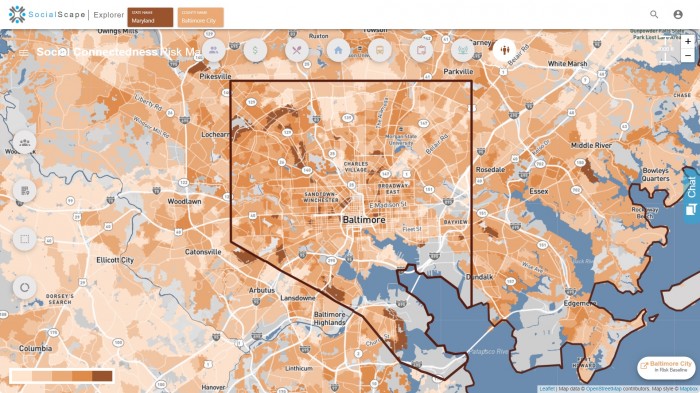Using Data to Quantify a Key Pandemic SDOH: Social Isolation
A company that helps providers and payers assess social risk has created a metric to help organizations understand how social isolation and loneliness impact communities across the country.

Source: Getty Images
- Loneliness and social isolation rose alarmingly during the COVID-19 pandemic as lockdowns proliferated and in-person gatherings were discouraged.
A critical social determinant of health (SDOH), social isolation is estimated to have increased by 6.7 percentage points during the pandemic.
To help combat this and other SDOH issues, providers and payers are turning to data analytics. Several companies have emerged that help healthcare stakeholders assess and measure SDOH data to guide their health equity efforts.
One such company is Socially Determined, which offers "social risk intelligence" to providers and payers through their SocialScape platform, according to Ashley Perry, chief solutions officer at Socially Determined, in a phone interview. By analyzing social risk scores within the populations they care for, the company helps healthcare stakeholders decide how and when to deploy targeted interventions to enhance population health.
The company, which has worked with several healthcare organizations like Aetna and ProMedica, provides metrics to assess traditional SDOH factors like housing and income. Now, the company has released a new metric, optimal for the current pandemic era: social connectedness.
A NEW SDOH METRIC FOR UNPRECEDENTED TIMES
The COVID-19 pandemic laid bare the widespread health inequities inherent in the US health system, making it clear that providers need to consider SDOH while providing care — not just during the pandemic but beyond.
SDOH are non-medical social factors, such as income and housing stability, access to transportation, race, and social isolation, that affect a wide range of health outcomes.
Social isolation has become especially widespread during the pandemic, affecting people from all age groups, including young people, who have not escaped unscathed and are experiencing high levels of anxiety and depression.
And it's not just mental health that is at stake. Social isolation is also associated with a spike in other health conditions, like heart disease and stroke.
So, even though social connectedness as an SDOH measure has been on Socially Determined's radar for years, the pandemic pushed it to the top of the company's priority list.
"It was clearly the pandemic and the resulting impact on our day-to-day lives [that] really shined a spot on the need for us to be able to quantify social connectedness in a comprehensive way for all of the organizations that we're working with," Perry said. "We were always going to do it, but we pulled it forward because we recognized the importance of being able to help health systems, health plans, sciences companies, and other organizations…quantify social connectedness for the communities that they serve."
Last month, the company launched the social connectedness metric, adding it to its existing social risk domains like food landscape and health literacy.

Source: Socially Determined
BUILDING THE METRIC
When assessing social risk across all its domains, Socially Determined looks at both community- and person-level risk factors.
"It is important to recognize that for any specific individual living within a community, they have person-specific factors that could either accelerate or mitigate the risk that they face at the community level," Perry said. "And so, we have built models that assess risk exposure at the community level, and then built complementary models that look at the person-level factors as well."
The new social connectedness metric aims to discover how certain factors converge to impact a community. It takes into account community-level degrees of social connectedness, which are influenced by three main factors: loneliness, social capital, and social network quality.
Within each of those influencers, Socially Determined examines several calculated measures called 'engineered features' that consist of different raw data elements.
For example, the number of single-person households within a community is one of the raw data elements included in an engineered feature called network density, Perry explained. The network density feature helps the company understand the density of the social network within a particular community. That gets rolled up into the social network quality influencer.
Another example is pet ownership, a raw data element included in an engineered feature known as social seclusion. That is then rolled up into the loneliness influencer.
"So, you can see how we kind of build from raw data elements to those engineered features, to the influencers, to our finished risk intelligence," Perry said. "And that same approach is applied across all of our different [social risk] domains."
To determine which raw data elements to include, Socially Determined's data science team researched the various factors that contribute to social connectedness. They harvested raw data elements from data sets covering the entire country.
"So, it really starts with building that model-first approach, and then being able to understand from a data perspective what data is available to support the model," she said.
As it stands, the metric only assesses social connectedness on a community level. Perry said that the next opportunity to assess and combat social isolation is to create an individual-level social connectedness metric that will complement the community-level one.
MODIFYING THE INDUSTRY'S APPROACH TO SDOH
Though there has been a tremendous advancement in SDOH data analytics in the last few years, there is an opportunity for organizations to take a more ardent analytics-first approach.
"There are a lot of organizations out there that are doing tremendous work around things like screening, but we know based on the work that we've done, that screening often misses the most vulnerable segments of a population," Perry said. "And the advantage you see in using an analytics-first approach is that it allows you to understand risk exposure for the entire community that you serve and the entire population that you bear risk for."
Understanding the community-level risk can help organizations tailor those SDOH efforts, like screenings and social services referrals, to specific populations.
"There is, unfortunately, no shortage of social risk and need," Perry said. "And so, the value that taking an analytics-first approach offers is helping organizations think very strategically about how they can best deploy the resources that they have available to most effectively mitigate that risk."
